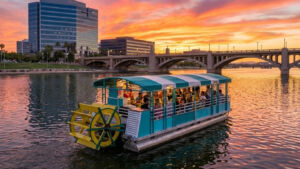Solo Travel in Arizona: Tips for an Amazing Adventure
Embark on an unforgettable solo journey through Arizona’s diverse landscapes and rich cultural tapestry. This guide offers expert-backed tips to help you make the most of your adventure, from early morning explorations to connecting with locals for authentic experiences. Discover how to balance famous attractions with hidden gems, prepare for remote travel, and find solitude in less-traveled areas, all while ensuring your safety and maximizing the beauty of the Grand Canyon State.
LOCAL NEWS: 100 best places to work and live in Arizona for 2025
INDUSTRY INSIGHTS: Want more news like this? Get our free newsletter here
- Beat the Heat with Early Morning Adventures
- Connect with Locals for Authentic Experiences
- Embrace the Golden Hour for Solo Exploration
- Leave Room for Unexpected Discoveries
- Mix Outdoor Adventure with Cultural Immersion
- Find Solitude in Less-Traveled National Monuments
- Time Your Activities for Safety and Scenery
- Balance Famous Spots with Hidden Treasures
- Prepare for Remote Travel Emergencies
- Protect Yourself from High-Altitude Sun Exposure
- Rent a Car for Freedom and Flexibility
- Explore Historic Towns at Your Own Pace
- Join Guided Tours for Safe Outdoor Adventures
Beat the Heat with Early Morning Adventures
My advice for traveling solo in Arizona is to plan your days around the early mornings and late afternoons. The heat can be overwhelming if you are not used to it, and at The Traveler, we often remind readers that sunrise hikes in Sedona or the Grand Canyon are not only safer but also the most memorable part of the trip.
Solo travelers can make the most of Arizona by leaning into its social side too. Joining a guided jeep tour or a small group hike is something I have done myself, and it strikes the right balance. You enjoy the freedom of solo travel while still meeting people who share your curiosity for the desert.
Alex Cornici, Founder and Editor-in-Chief, The Traveler
Connect with Locals for Authentic Experiences
Solo travelers in Arizona can reach out to local photography or hiking groups via community centers and outdoor gear stores. This strategy not only makes it easier to instantly meet companions but also helps to stay safe in a desert that can be deadly for an uninitiated solo traveler. In my research into the culture of Arizona while out there, I ended up in a photography group for sunrise in Sedona and met local artists who were friends. They invited me to exclusive studio visits and local pottery workshops that tourists never find. These “real” community links converted my solo research trip into a rich cultural sabbatical, unveiling vibrant contemporary arts in Arizona alongside its ancient Indigenous artifacts.
Arizona for Solo Travel: Solo travel in Arizona is at its best when you’re hanging out with the locals and getting right into those well-kept local secrets which the locals really enjoy more than many of the more expected lists of tourist traps that garner repeat visits from travelers to another place. Rise and shine with morning hiking groups leaving from nearby trailheads, get that perfect shot with a sunset photography workshop during golden hour, or visit weekend farmers markets that feature local artisans showcasing traditional Southwestern crafts and desert life.
These organic meeting spots afford opportunities to have authentic conversations over cuisine with locals, who’ll then suggest under-the-radar cultural spots, safe routes through the mountains, and places for tipping back Kingfisher beers that you won’t find in your guidebook. This is because we understand the Arizona experience isn’t complete unless it features both self-discovery and meaningful community.
Yunna Takeuchi, Co-founder & CXO, City Unscripted
Embrace the Golden Hour for Solo Exploration
Solo travel in Arizona is incredibly rewarding because you can move at your own pace and really connect with the landscape.
My biggest piece of advice would be to embrace the early morning hours — especially in the desert regions. Arizona’s magic happens at sunrise when the temperatures are perfect, and the light is stunning for photography. The “golden hour” starts about 30-45 minutes before sunrise and continues for about an hour after. You will have many of the iconic spots, like Camelback Mountain or Bell Rock, completely to yourself.
Maddison Ryan, Owner, Traveling Italian
Leave Room for Unexpected Discoveries
My advice to someone traveling to Arizona alone is to leave at least one day completely unscheduled. When I did this on my own trip, I discovered that Arizona’s magic isn’t just in the famous landmarks but in the unexpected stops along the way. I remember pulling over at a tiny desert cafe just because the mural on the wall caught my eye. I ended up talking with the owner, hearing about the town’s history, and even got directions to a trail that wasn’t listed anywhere online. That moment of openness turned into one of the highlights of my trip.
What made it even more meaningful was the freedom I felt exploring with no agenda. Traveling alone gives you the perfect chance to follow your curiosity without worrying about someone else’s schedule. By leaving space to wander, you let Arizona surprise you, and often those surprises become the memories that stay with you the longest.
Liam Derbyshire, CEO / Founder, Influize
Mix Outdoor Adventure with Cultural Immersion
Take advantage of early mornings — Arizona’s natural beauty is most gorgeous and serene during the hour after sunrise, such as in Sedona, the Superstition Mountains, and Saguaro National Park. For solo travelers, the quiet hours are an ideal time to enjoy a trail without the crowds and to beat the desert’s sweltering heat. To get the most out of your trip, mix outdoor adventure with cultural discovery: join a Navajo-led tour in Monument Valley, visit Indigenous art markets, or check out creative neighborhoods in Tucson and Phoenix. Arizona offers a perfect place to travel alone, with opportunities for both solitude and community — like staying in a locally run guest house, joining group hikes, or allowing the rhythm of the desert to direct your own rhythm.
Alex Veka, Founder, Vibe Adventures
Find Solitude in Less-Traveled National Monuments
I was fortunate enough to go to Arizona alone as part of a wellness retreat I had provided for myself after completing a rather intense yoga teacher training program. The thing I have done to make the most of that trip was to visit the less popular parks because traveling alone gives you the freedom to shape each day specifically the way you want. In Chiricahua National Monument, I could move at my own pace, make stops where I wanted, and take up to hours along the paths without being interrupted. Because of that, it made the hikes more meaningful as every choice was mine.
I then proceeded to Organ Pipe Cactus National Monument, and the experience of camping alone made me trust in myself and gain confidence. Every morning, I made my own agenda and did yoga outdoors and journaling without interruption. Choosing these more peaceful parks made the solo journey more gratifying, since the experience was about developing trust within myself and appreciating the beauty of Arizona.
Meera Watts, Founder and CEO, Siddhi Yoga
Time Your Activities for Safety and Scenery
I suggest planning your trip around the time of year and day. Arizona is beautiful, but timing is key for safety. In the summer, hiking in Sedona or the Grand Canyon in the middle of the day can be risky because of the heat. If you go at sunrise or sunset, the weather is cooler, and the views are incredible. When I traveled alone, I started hiking before 7 a.m. Then, I spent the afternoons in towns, museums, or on scenic drives in shady canyons. As a solo traveler, this routine helped me meet other early birds on the trail, which felt safer. It also gave me time to enjoy peaceful moments. If you also check in often with someone at home to share your plans, you can have a fun trip and still feel secure.
Joe Chanda, Owner, Bully Beds
Balance Famous Spots with Hidden Treasures
Advice I’d give to someone visiting Arizona alone: The state is full of breathtaking landscapes, so go at your own pace and enjoy it. Hike the trails in Sedona, watch the sunrise at the Grand Canyon, or soak in the desert views around Tucson. When you’re traveling solo, it’s easy to stop where you want, take as long as you want, and truly immerse yourself in the views. My tip: Make sure you balance out the famous spots with some lesser-known trails — get to know the “must-see” Arizona, but also find some of the state’s hidden treasures.
It’s also important to make time to relax: Watch a sunset, enjoy a local coffee shop, or even take a day off to rest and journal your trip. Just make sure you stay safe: Check the trail conditions, pack plenty of water, and let someone know where you’re going. Traveling alone in Arizona is a must because the views are just so rewarding — the state is so big and awe-inspiring that you’ll come back with great photos and a newfound appreciation for your independence.
Jackie Sons, Owner, Native Wildflowers Nursery
Prepare for Remote Travel Emergencies
Install the emergency contact applications of tribal police departments prior to exploring the remote regions of Arizona, since typical 911 systems rarely work in expansive regions of Native American lands that span 27% of the state. The Navajo Nation Police has 210 officers to serve 17.5 million acres, which results in areas of communication dead zones with cell towers spaced out at 50 or more miles. Solo travelers who break down or become injured in locations such as Monument Valley or Canyon de Chelly can take 6-8 hours to be rescued due to the inability of dispatchers to trace them using traditional emergency systems.
Pack up 2 gallons of water per day for backcountry travel and bring $200 in cash in case of an unplanned roadside assistance bill. Remote desert rescues are priced at a premium by towing companies, with base fees of about $150 and $8 per mile to the closest town. Contrary to what many think about Arizona being a state of all-access highways, more than 40% of the state would require high-clearance vehicles to access the most beautiful sites and secret slot canyons that individual explorers usually visit to get that ideal social media post.
Kaila Hattis, Founder and Therapist, Pacific Coast Therapy
Protect Yourself from High-Altitude Sun Exposure
Massive UV exposure at high altitudes in Arizona often takes solo travelers by surprise. At 7,000 feet above sea level, the sun is 25% more intense than at the shoreline, and many mountain cities such as Flagstaff and Sedona are much higher than this. The majority of travelers apply regular SPF 30 sunscreen and believe they are safe, yet SPF 50 is the minimum protection needed, and it should be reapplied every 90 minutes, not once every two hours. Wraparound UV400 sunglasses are also required to protect your eyes, as the desert reflects radiation in many directions.
Individual hiking is ideal during the shoulder seasons from late October through early December and mid-February through April. These windows offer an ideal temperature of 70 degrees without the crushing summer heat or winter snow at higher elevations. Get the AllTrails app and explore some less popular places such as the Wave Cave Trail near Page or Secret Canyon near Sedona. These locations feature stunning red rock formations similar to well-known sites but with 80% fewer visitors, providing the solitude that makes solo travel so valuable.
Gregg Feinerman, Owner and Medical Director, Feinerman Vision
Rent a Car for Freedom and Flexibility
If your itinerary includes destinations outside major cities, consider renting a car. Public transportation options remain limited outside of Phoenix and Tucson, so car rental remains the most practical mode of transport. Prior to departure, verify that the gas tank is full, since fueling stations in the state’s more remote areas can be far apart. For insurance against potential signal loss, carry a physical map to supplement your navigation app. Drive at a measured pace; deer and elk often cross roads at dawn and dusk.
While a good vehicle is essential, so too is robust travel insurance. Solo travelers, in particular, benefit from coverage against breakdowns, medical emergencies, or itinerary changes; these policies can turn a potentially distressing incident into a manageable inconvenience.
Joe Cronin, President, International Citizens Insurance
Explore Historic Towns at Your Own Pace
In case you travel alone in Arizona, I would recommend preferring places where history and quiet scenery are combined. Spend time in Jerome, where you can wander through its hillside streets, visit small galleries, and look out over wide desert views. Slowly strolling along this old mining town provides you with the opportunity to take in the ambiance of the town without having to map out a plan or timetable.
To make the most of your trip, include visiting Montezuma Castle National Monument too. When you are standing in front of the ancient cliff dwellings, it allows you to relate to the history of the people who lived there centuries ago. The limited path around the site is ideal for a lone traveler in need of time to walk at his/her own pace. Jerome and Montezuma Castle are two stops that provide a quiet moment of history and beauty to turn a solitary trip into a more intimate one.
Miguel Angel Gongora Meza, Founder & Director, Evolution Treks Peru
Join Guided Tours for Safe Outdoor Adventures
Unless you are visiting northern Arizona, where the Grand Canyon, Flagstaff, Lowell Observatory, and Antelope Canyon are all amazing, don’t come in the summer. AZ is for outdoors! Eat outdoors, walk outdoors, hike outdoors, sightsee outdoors, etc. Our people are really friendly, but our climate can be dangerously hot. You shouldn’t hike alone, nor ever without way more water than you think you need. We have lots of groups, clubs, and tours with guides for amazing outdoor adventures. Just ask around, online or face-to-face, for some good company.
Victoria Powell, Artist & Gallery Owner, Victoria J Powell Art




